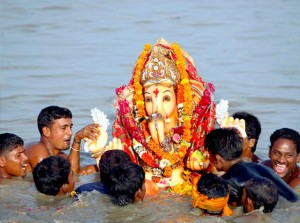 It is one of the major traditional festivals celebrated by the Hindu community. It is observed in the Hindu calendar month of Bhadrapada, starting on the shukla chaturthi (fourth day of the waxing moon period). Typically the day falls sometime between August and September . The festival lasts for 10 days, ending on Ananta Chaturdashi, and is traditionally celebrated as the birthday of Lord Ganesha.
It is one of the major traditional festivals celebrated by the Hindu community. It is observed in the Hindu calendar month of Bhadrapada, starting on the shukla chaturthi (fourth day of the waxing moon period). Typically the day falls sometime between August and September . The festival lasts for 10 days, ending on Ananta Chaturdashi, and is traditionally celebrated as the birthday of Lord Ganesha.
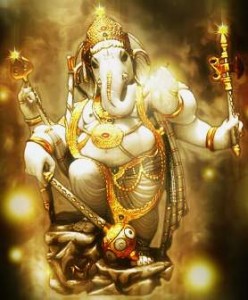 According to Hindu tradition, Lord Ganesha is the son of Shiva (The God of Destruction in the Hindu Holy Trinity of Creator-Preserver-Destroyer) and Parvati (Shiva's consort). The cutest and most lovable Indian God, Ganesha or Ganpati has the head of an elephant on which rests an elegant tiara, four podgy hands joined to a sizeable belly with each hand holding its own symbolic object - a trishul or a trident in one, an ankush or goad (made from his very own broken tooth) in another, a lotus in the third and a rosary (which is sometimes replaced by modaks, his favourite sweet) in the fourth. Revered as the deity of auspiciousness and wisdom, Lord Ganesha is also famous for being a trickster and for his profound sense of humour.
According to Hindu tradition, Lord Ganesha is the son of Shiva (The God of Destruction in the Hindu Holy Trinity of Creator-Preserver-Destroyer) and Parvati (Shiva's consort). The cutest and most lovable Indian God, Ganesha or Ganpati has the head of an elephant on which rests an elegant tiara, four podgy hands joined to a sizeable belly with each hand holding its own symbolic object - a trishul or a trident in one, an ankush or goad (made from his very own broken tooth) in another, a lotus in the third and a rosary (which is sometimes replaced by modaks, his favourite sweet) in the fourth. Revered as the deity of auspiciousness and wisdom, Lord Ganesha is also famous for being a trickster and for his profound sense of humour.
It is believed that Lord Ganesh was born on a fourth day (chaturthi) of the bright fortnight of the Hindu lunar month of Magh. Since then, an association between Ganesh and chaturthi has been established. Thus the festival dedicated to the worship of Lord Ganesha on this chaturthi day is named as Ganesh Chaturthi.
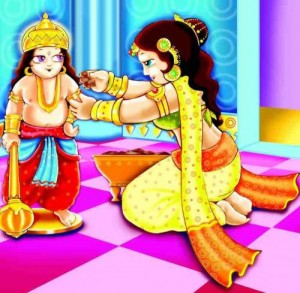 There is a curiously interesting tale about the birthof Ganesha. It is believed that once while Parvati was bathing, she created a human figure from some unguent and balm, gave him life and asked him to guard the door while she bathed.
There is a curiously interesting tale about the birthof Ganesha. It is believed that once while Parvati was bathing, she created a human figure from some unguent and balm, gave him life and asked him to guard the door while she bathed.
After a long period of meditation on Mountain Kailash (Lord Shiva's abode), Shiva chose that very moment to drop by to see his better half, but was abruptly stopped by the man-god Parvati had posted at the door. Outraged by the cheek of this stranger, Shiva cut off his head only to discover moments later that he had killed Parvati's son! For fear of enraging his wife, Shiva immediately dispatched his ganas (attendants) to get him the head of the first living creature they could find. Well, the first living creature happened to be an elephant.
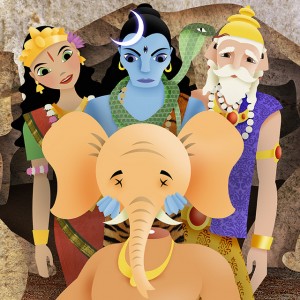 As instructed, the head was chopped off and brought back to Shiva, who placed it on Parvati's son's body, bringing him back to life. This elephant-headed god was welcomed into the first family of the Hindu heavens and named Ganesha or Ganapati, which literally means the chief of the ganas, or the attendants of Shiva. Ganesha is the foremost god of the Hindu pantheon. This brave guardian of the door to Parvati's bath is beheld today as the most auspicious God of new beginnings. He is worshipped during every festival and before people undertake a journey or embark upon a new venture. You will also see him carefully guarding entrances to temples and homes, peeping out of calendars and happily gracing marriages and other such occasions.
As instructed, the head was chopped off and brought back to Shiva, who placed it on Parvati's son's body, bringing him back to life. This elephant-headed god was welcomed into the first family of the Hindu heavens and named Ganesha or Ganapati, which literally means the chief of the ganas, or the attendants of Shiva. Ganesha is the foremost god of the Hindu pantheon. This brave guardian of the door to Parvati's bath is beheld today as the most auspicious God of new beginnings. He is worshipped during every festival and before people undertake a journey or embark upon a new venture. You will also see him carefully guarding entrances to temples and homes, peeping out of calendars and happily gracing marriages and other such occasions.
It is not known when and how Ganesh Chaturthi was first celebrated. But according to the historian Shri Rajwade, the earliest Ganesh Chaturthi celebrations can be traced back to the times of the reigns of dynasties as Satavahana, Rashtrakuta and Chalukya.
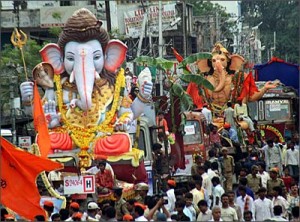 Historical records reveal that Ganesh Chaturthi celebrations were initiated in Maharashtra by Chatrapati Shivaji Maharaja, the great Maratha ruler, to promote culture and nationalism. And it had continued ever since.
Historical records reveal that Ganesh Chaturthi celebrations were initiated in Maharashtra by Chatrapati Shivaji Maharaja, the great Maratha ruler, to promote culture and nationalism. And it had continued ever since.
There are also references in history to similar celebrations during Peshwa times.It is believed that Lord Ganapati was the family deity of the Peshwas. After the end of Peshwa rule, Ganesh Chaturthi remained a family affair in Maharashtra from the period of 1818 to 1892. 1857 was a landmark year for India and more so in the context of Indian freedom. It was the year of Sepoy Mutiny, an armed rebellion against the ruling British Empire by the Indian soldiers. This was the first war that India waged to gain back her independence from her white rulers. Though unsuccessful, this battle marked the beginning of the Indian struggle for independence.
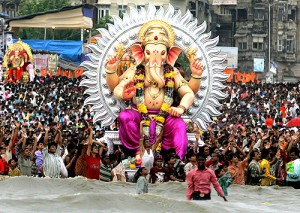 Many orators, leaders and freedom fighters all over India teamed to put up a united resistance to the British domination. One of these eminent leaders was Bal Gangadhar Tilak, an Indian nationalist, social reformer and freedom fighter. Greatly esteemed by the Indian people, especially of Maharashtra, Tilak was commonly referred to as "Lokmanya" or "he who is regarded by the people".
Many orators, leaders and freedom fighters all over India teamed to put up a united resistance to the British domination. One of these eminent leaders was Bal Gangadhar Tilak, an Indian nationalist, social reformer and freedom fighter. Greatly esteemed by the Indian people, especially of Maharashtra, Tilak was commonly referred to as "Lokmanya" or "he who is regarded by the people".
It was Tilak, who brought back the tradition of Ganesh Chaturthi and reshaped the annual Ganesh festival from private family celebrations into a grand public event.
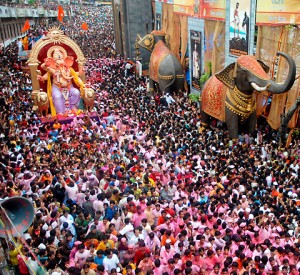 Lokamanya saw how Lord Ganesha was worshipped by the upper stratum as well as the rank and file of India. The visionary that he was, Tilak realized the cultural importance of this deity and popularised Ganesha Chaturthi as a National Festival "to bridge the gap between Hindus and find an appropriate context in which to build a new grassroots unity between them" in his nationalistic strivings against the British in Maharashtra. He knew that India couldn't fight her rulers until she solved the differences within her own. Hence, to unite all social classes Tilak chose Ganesha as a rallying point for Indian protest against British rule because of his wide appeal as "the god for Everyman".
Lokamanya saw how Lord Ganesha was worshipped by the upper stratum as well as the rank and file of India. The visionary that he was, Tilak realized the cultural importance of this deity and popularised Ganesha Chaturthi as a National Festival "to bridge the gap between Hindus and find an appropriate context in which to build a new grassroots unity between them" in his nationalistic strivings against the British in Maharashtra. He knew that India couldn't fight her rulers until she solved the differences within her own. Hence, to unite all social classes Tilak chose Ganesha as a rallying point for Indian protest against British rule because of his wide appeal as "the god for Everyman".
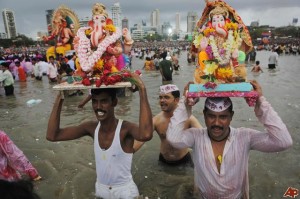 It was around 1893, during the nascent stages of Indian nationalism, that Tilak began to organize the Ganesh Utsav as a social and religious function. He was the first to put in large public images of Ganesha in pavilions and establish the tradition of their immersion on the tenth day.
It was around 1893, during the nascent stages of Indian nationalism, that Tilak began to organize the Ganesh Utsav as a social and religious function. He was the first to put in large public images of Ganesha in pavilions and establish the tradition of their immersion on the tenth day.
The festival facilitated community participation and involvement in the form of learned discourses, dance dramas, poetry recital, musical concerts, debates, etc. It served as a meeting place for common people of all castes and communities, at a time when all social and political gatherings were forbidden by the British Empire for fear of conspiracies to be hatched against them. An important festival during the Peshwa era, Ganesha Chaturthi acquired at this time a more organized form all over India largely due to Lokmanya's efforts.
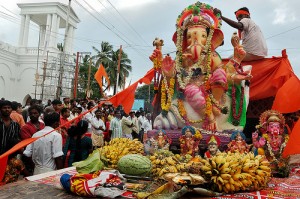 Since then, Ganesh Chaturthi has been celebrated throughout Maharashtra as also in other states with great community enthusiasm and participation. With the independence of India in 1947, it was proclaimed to be a national festival.
Since then, Ganesh Chaturthi has been celebrated throughout Maharashtra as also in other states with great community enthusiasm and participation. With the independence of India in 1947, it was proclaimed to be a national festival.
Today, Ganesh Chaturthi is celebrated in the states of Maharashtra, Tamil Nadu, Karnataka and Andhra Pradesh and many other parts of India. The festival is so popular that the preparations begin months in advance. Days before the actual worship, homes are cleaned and marquees erected at street corners to house the deities of the Lord.
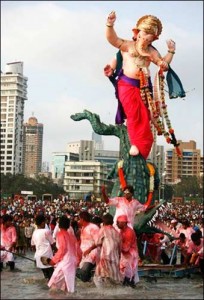 Elaborate arrangements are made for lighting, decoration, mirrors and flowers. The artisans who make the idols of Ganesh vie with each other to make bigger and better sculptures. The sizes of the relatively larger ones range anywhere from 10 meters to 30 meters in height. These are installed in marquees and in homes prior to the Puja (worship). During the festival days, the Lord is worshipped with great devotion and prayer services are performed daily.
Elaborate arrangements are made for lighting, decoration, mirrors and flowers. The artisans who make the idols of Ganesh vie with each other to make bigger and better sculptures. The sizes of the relatively larger ones range anywhere from 10 meters to 30 meters in height. These are installed in marquees and in homes prior to the Puja (worship). During the festival days, the Lord is worshipped with great devotion and prayer services are performed daily.
The duration of the Lord's stay varies from place to place; once the worship is complete, the statues are carried on decorated floats to be immersed in the sea after one, three, five, seven and ten days. Thousands of processions converge on the beaches to immerse the holy idols in the sea.
This procession and immersion is accompanied with dancing and the sound of exciting drum-beats, devotional songs and exploding firecrackers. As the deity is immersed amidst loud chants of "Ganesh Maharaj Ki Jai!" (Hail Lord Ganesh), the festival comes to an end with pleas to the Lord to return the next year with chants of "Ganpati bappa morya, pudcha varshi laukar ya" (Hail Lord Ganesh, return again soon next year).
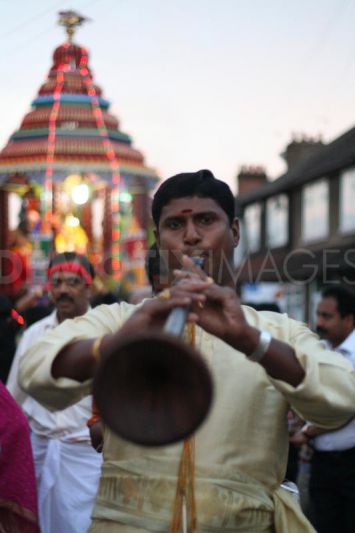 Tourists from all over the world come to witness this wonderful event in the sun kissed beaches of Goa and Mumbai.While celebrated all over India, Ganesh Chaturthi festivities are most elaborate in states like Maharashtra, Goa (It is the biggest festival for Konkani people all over the world), Gujarat, Karnataka and Andhra Pradesh, and other areas which were former states of the Maratha Empire. Outside India, it is celebrated in Nepal by the Newars.
Tourists from all over the world come to witness this wonderful event in the sun kissed beaches of Goa and Mumbai.While celebrated all over India, Ganesh Chaturthi festivities are most elaborate in states like Maharashtra, Goa (It is the biggest festival for Konkani people all over the world), Gujarat, Karnataka and Andhra Pradesh, and other areas which were former states of the Maratha Empire. Outside India, it is celebrated in Nepal by the Newars.
In the 21st century, with the world turning fast into a global village, Ganesh Chaturthi is now celebrated all over the world, wherever there is a presence of a Hindu community.
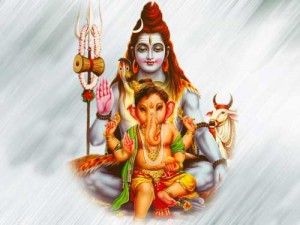 The sacred festival of Ganesh Chaturthi. Ga' symbolises Buddhi (intellect), Na' stands for Vijnana (wisdom). So, Ganapati is the master of Buddhi and Vijnana. The universe is sustained by Ganas (gods) and Ganapati is their master. In this world, everybody has a master, but Ganapati has none. He is a master by himself.
The sacred festival of Ganesh Chaturthi. Ga' symbolises Buddhi (intellect), Na' stands for Vijnana (wisdom). So, Ganapati is the master of Buddhi and Vijnana. The universe is sustained by Ganas (gods) and Ganapati is their master. In this world, everybody has a master, but Ganapati has none. He is a master by himself.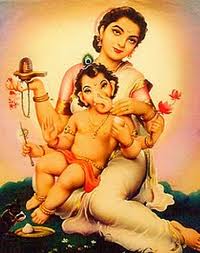 You may wonder how a small mooshika can carry on its back a hefty personality like Vinayaka. Here mooshika does not mean a mere mouse. It symbolises the darkness of ignorance because it is in darkness that the mouse moves about. Hence, Mooshika Vahana is one who subdues ignorance and dispels darkness. It is only when we understand the inner significance of the Vinayaka principle that we will be able to celebrate Vinayaka Chaturthi properly.
You may wonder how a small mooshika can carry on its back a hefty personality like Vinayaka. Here mooshika does not mean a mere mouse. It symbolises the darkness of ignorance because it is in darkness that the mouse moves about. Hence, Mooshika Vahana is one who subdues ignorance and dispels darkness. It is only when we understand the inner significance of the Vinayaka principle that we will be able to celebrate Vinayaka Chaturthi properly.People perform Vinayaka worship without actually understanding its significance. Vinayaka symbolises the qualities of a true leader in all aspects. "Viyate Nayake Iti Vinayaka" meaning, He is a master unto Himself. In this world Vinayaka is worshipped by many. However, Vinayaka does not worship anyone as He has no master above Him. Even Easwara, the father, worships His son Vinayaka, but it does not happen the other way.
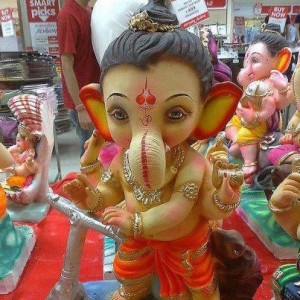 Vinayaka is also called Vighneswara (remover of obstacles). No obstacle can come in the way of one who prays to Vinayaka. Worship of Vinayaka confers success in spiritual as well as worldly endeavours. God grants happiness at two levels, Pravritti (outward) and Nivritti (inward). Pravritti is related to physical body whereas Nivritti to intellect. The former undergoes change with the passage of time, whereas the latter remains unchanged. Hence, one should try to reduce body attachment with proper food and habits." ..Sathya Sai Baba
Vinayaka is also called Vighneswara (remover of obstacles). No obstacle can come in the way of one who prays to Vinayaka. Worship of Vinayaka confers success in spiritual as well as worldly endeavours. God grants happiness at two levels, Pravritti (outward) and Nivritti (inward). Pravritti is related to physical body whereas Nivritti to intellect. The former undergoes change with the passage of time, whereas the latter remains unchanged. Hence, one should try to reduce body attachment with proper food and habits." ..Sathya Sai Baba
More on Lord Ganesh
Out of all the deities in the Hindu pantheon Ganesh, is one of the most popular. He is the Lord of Obstacles', and Leader of the Celestials'. Each aspect of the image of a Hindu deity contains a meaning or message. Here we use the image of Ganesh to demonstrate this, and relate it to leadership and overcoming obstacles.
Elephant trunk
An elephant's trunk is not used to make noise very often. But when it does - the noise is clear, loud and glorious. In the same way it is a quality of a good leader to not waste words unnecessarily but to ensure that whatever is said should be clear, well thought out and profound.
One broken tusk, one large tusk
Ganesh is shown as having one broken tusk, and one full tusk. It is said that the short tusk represents the intellect, whereas the full tusk represents sraddha (faith). The intellect is limited. We should use it to full capacity - but there is only so far it can take us. Beyond this point it is our faith that we have to rely on. Faith does not necessarily imply a religious belief. It is a certain conviction of our heart, a conviction in the rightness of a cause, to go beyond our usual set boundaries. This is particularly relevant when undertaking new endeavours, hence the worship of Ganesh at this time in particular.
Large ears
Large ears relate to listening. Listening attentively to all that is going on around us, as well as to the people in our lives, is an important quality. One of the main problems in interpersonal relations is that we don't truly listen. Also, we don't listen to nature, which if we are perceptive is sending us messages all the time.
Mouse as companion
There are several meanings traditionally associated with Ganesh's strange choice of companion. Two of them are as follows:
1) Equality of company. Ganesh befriends all, including the person who is from a very different species. People who are truly noble understand that we may be able to draw our friends, advisors or colleagues from all walks of life. There is a lesson to learn from everyone, no matter how lowly they may seem, and the Supreme soul is present in all beings, high and low.
2) The mouse is sometimes compared to our thoughts, because our thoughts (just like a mouse) are hard to control, and always on the move from one place to another. It is the ability to control our thoughts, keeping them at one point, which is being symbolised.
One foot in on the floor, one foot raised
This represents the Vedic teaching that an individual should live life with "one foot in the material world and one foot beyond the world". That means that our worldly affairs should be given due care and attention, but that we should also cultivate a spiritual dimension to our lives which is removed from the ups and downs of everyday life. It is unbalanced living if we set all our attention to this fleeting, impermanent world, without learning to live in deeper harmony with the eternal truths of existence. It is also impartial living is we just pursue transendental spirituality with no care of worldly duties and needs. A balance must be struck where spirituality enriches rather than hinders worldly pursuits. Ganesh, to the Hindu mind, symbolises this balance, where spirituality and worldly endeavours are beautifully harmonised.
Contemplation/Meditation on an Image
The imagery within Hinduism is very profound and contains various layers of meanings. The importance in knowing the meanings behind these is related to our subconscious mind. When we know the meanings, they become stored in our memories. When we concentrate on the image, even though we are not consciously remembering all of the meanings contained within, the subconscious mind is reinforcing these messages into our character. It is in the same way that we pick up so much from our surroundings, without consciously trying to. This is a subconscious process. The action of the subconscious mind while praying and meditating is explained in depth in various scriptures, particularly the Patanjali's Yogasutras. Understood like this, concentration on an image such as that of Ganesh becomes an important and meaningful part of our spiritual practice. Such worship is like stream of clear water purifying our mind and consciousness.


